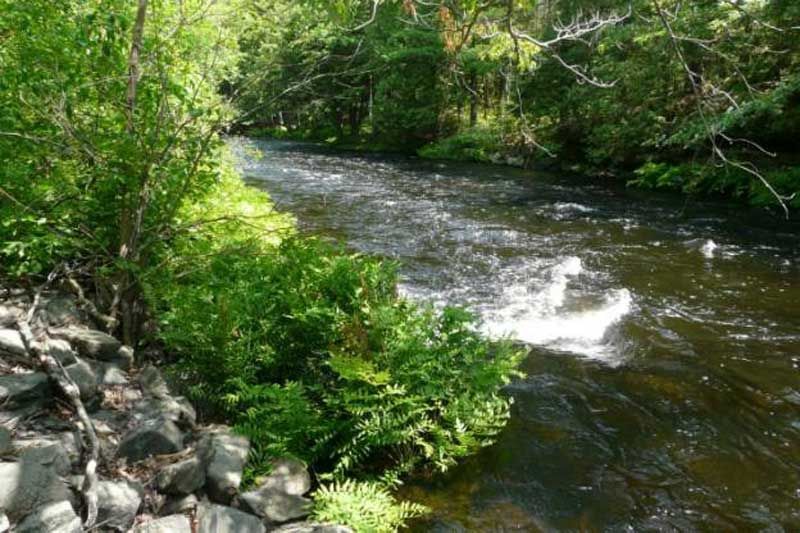Gray Merriam | May 28, 2015
Preserving the health of a river begins with care of the land throughout the watershed, and the shoreline is one important part of that care. The vegetation near the shores provides most of that care without our intervention. We can simply let it do its work.
The Friends of the Salmon River recognizes the Ribbon of Life standard: the first 30 metres or 100 feet back from the water's edge should be left in a natural state as much as possible.
Roots of vegetation near the shores mechanically stabilize the banks. Incorporated into the soil, the organic matter produced by shoreline plants helps bind soil particles together into aggregates that resist flowing into the river. The leaf litter under shoreline trees and shrubs becomes infiltrated by the mycelial mass of fungi and much of the nutrient-enriched runoff from your land is absorbed by these fungal strands and kept out of the river. All together, the natural vegetation and its litter will do a good job of keeping the river ecologically healthy and beautiful.
If there are large trees between your home and the river, cutting them down to improve your view damages the beauty you are trying to see. A smarter method is to prune the bottom half or two-thirds of the branches. Most healthy trees can withstand this intensity of pruning. This way, the roots remain in the soil to hold the bank together and you have a nice view of the river.
Balance a desire for river views and reasonable access to the water with the natural processes that maintain the health of the river.
When cutting wood, keep in mind that branches or trees left to float in the water can be very dangerous for paddlers and boaters on the river, so these should be removed. Habitat piles for wildlife on your land is a good use for leftover brush. For more information, see: friendsofsalmonriver.ca.
Vehicles in the River: When water levels are low in the Salmon River, ATVs and trucks are sometimes seen driving right into the riverbed - even being washed there. This is damaging in many ways: gas, oil, grease and other chemicals from vehicles contaminate the waterway. Driving on and trampling the vegetation on the shore leaves it open to erosion, which can degrade water quality and fish/wildlife habitat. This practice is so harmful. Perhaps our ancestors washed their horses in the river, which was fine. Vehicles in the river are not. Our children learn from our actions, and surely we want them to grow up with a respect for our rivers and waterways.
The desires of the people on the land and visitors on the river can all be satisfied and the river can be cared for if we can all act as good stewards.
More Stories
- September Closures for Northbrook And Sharbot Lake Beer Stores
- This "Doc Is Not In Anymore" After 54 Years
- Mazinaw Lake Swim Program Only Getting Stronger After 53 Years
- "Jack of Diamonds, Jack of Diamonds" but No Ace Of Spades Yet
- Sydenham Legion Presents ATV to Canada Day Raffle Winner
- Bathing in Blue Mindfulness: An Otter Lake Journey in Frontenac Park
- Central Frontenac Buys Used Pumper At Special Meeting
- 4th Annual Sharbot Lake Beach Bash
- Frontenac ATV Club Rallies For A Community Cause
- Harrowsmith Shadowdale Blooms: Kindness In Full Colour

